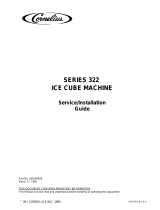
Introduction
This technical manual covers the Prodigy line, excluding the Eclipse remote low side models.
All models except Eclipse are shipped with an Installation and User's manual, which can be
referred to separately. General installation information is included in this manual.
September 2006 Page 1
Table of Contents
Model Number Description ......... page 2
Water .................... page 3
General Installation - Air or Water Cooled . page 4
Water purge setting ............ page 8
General Installation - Remote ....... page 9
Pre-Charged Tubing Coupling Connections page 17
Adjustments ................ page 20
Prodigy Cuber System Information..... page 21
Controller Information ........... page 22
How It Works - Air Cooled ......... page 24
How It Works - Water Cooled ....... page 25
How It Works - Remote........... page 26
Electrical Sequence - Air or Water Cooled. page 27
Electrical Sequence - Remote Cooled . . . page 29
Remote Schematics ............ page 31
Electrical Component Details ....... page 32
Refrigeration ................ page 35
Water System ............... page 36
Control Operation ............. page 37
Control Safeties .............. page 38
Restarts................... page 39
Control Button Use (from standby) ..... page 40
Control Button Use - continued ...... page 41
Diagnostics – Air Cooled .......... page 42
Low Ice Making Capacity - Air Cooled . . . page 45
Makes Excessive Noise - Air Cooled.... page 46
Diagnostics - Water Cooled ........ page 47
Low ice Making Capacity - Water Cooled . page 50
Makes Excessive Noise - Water Cooled . . page 51
Diagnostics - Remote Air Cooled ..... page 52
Low Ice Making Capacity - Remote .... page 55
Makes Excessive Noise - Remote ..... page 56
Test Procedures - Sensors......... page 57
Ice Thickness Sensor ........... page 58
Water Level Sensor ............ page 59
Temperature Sensors ........... page 60
Test Procedures - Loads .......... page 61
Compressor Electrical Chart ........ page 62
Test Procedures - Loads .......... page 63
Technical Information ........... page 71
Heat Load & Condenser Water GPM . . . page 72
Controller Differences ........... page 73
Thermistor Values ............. page 74
Performance Data ............. page 75
Performance Data - Remotes ....... page 85
Wiring Diagrams .............. page 93
Repair Procedures ............. page 101
Refrigeration Removal and Replacement Procedures
.......................page 109
Optional add-on control information .... page 114




















